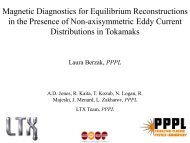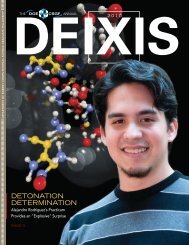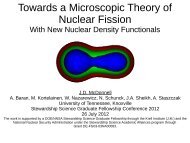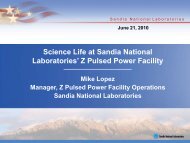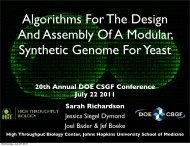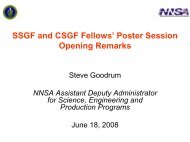2012 - Krell Institute
2012 - Krell Institute
2012 - Krell Institute
Create successful ePaper yourself
Turn your PDF publications into a flip-book with our unique Google optimized e-Paper software.
forever. But most remained, and after a<br />
journey of 13 billion years, some of that<br />
radiation finally comes to rest ... in our<br />
TV antennas.<br />
That’s right: About 20 percent of the<br />
static you see on an old TV is radiation<br />
from this so‐called Cosmic Microwave<br />
Background (CMB). In fact, this leftover<br />
radiation from the Big Bang is by far the<br />
brightest thing in the universe. If our eyes<br />
could see microwaves, it would outshine<br />
the stars, the sun, and anything made by<br />
humans. That’s how we know the<br />
primeval universe was peach-sized and<br />
hot: It’s the only explanation for the way<br />
this radiation appears today. Studying<br />
the CMB helps us understand the<br />
universe’s earliest moments.<br />
Scientists have observed the<br />
Cosmic Microwave Background for<br />
about 50 years. The latest effort, from<br />
the European Space Agency, is based on<br />
the Planck satellite, which tirelessly<br />
sweeps across the heavens, measuring<br />
and probing this old, tired light.<br />
The satellite, launched in May<br />
2009, is good – too good, in fact. It’s<br />
performing beyond expectations,<br />
constantly delivering an enormous<br />
amount of data even past its expected<br />
lifetime. We must squeeze every last bit<br />
of insight out of these data if we are to<br />
understand our early universe. That<br />
requires new algorithms – mathematical<br />
recipes – and computational techniques to<br />
handle, categorize, filter and process this<br />
information into meaningful science.<br />
One essential algorithm I helped<br />
develop is the spherical convolution,<br />
named because Planck sees the sky as a<br />
complete sphere. In effect, this algorithm<br />
“smoothens” the microwave signal,<br />
which is important for removing noise<br />
and holes in the data and for identifying<br />
important features of different sizes.<br />
I invented a new type of spherical<br />
convolution algorithm – one that runs on<br />
Graphics Processing Units (GPUs), the<br />
same hardware that makes modern video<br />
games so stunning. That means our<br />
algorithm is not only fast – about 20<br />
times faster than older approaches – but<br />
also cheap; a new GPU costs only about<br />
$500, peanuts for a multi-million-dollar<br />
research program.<br />
Our new algorithm has many<br />
applications besides studying the young<br />
universe. Need to use a satellite to<br />
search the Earth’s surface for oil or<br />
mineral deposits? We can speed you up.<br />
Trying to make artificial eyes correctly<br />
compute reflections off round surfaces?<br />
We can help. Trying to use the latest in<br />
medical imaging to diagnose cancer?<br />
Yup, that too. All these applications<br />
rely on spherical convolutions, and<br />
the faster the better.<br />
This is just one example of the<br />
serendipitous effects of these primary<br />
science missions. We’re constantly<br />
pushing the boundaries of hardware and<br />
software to acquire and understand our<br />
data. New machines, new techniques,<br />
new tools and new algorithms all come<br />
along at no extra charge when we do our<br />
best to look up into the night sky and see<br />
as far as we can into the past.<br />
A view of the Cosmic Microwave Background as the Planck satellite<br />
sees it and an enlarged portion of the image. Small differences in<br />
temperature reveal the structure of the very early universe.<br />
DEIXIS 12 DOE CSGF ANNUAL P29



